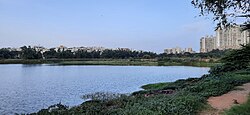Madiwala Lake
This article includes a list of general references, but it lacks sufficient corresponding inline citations. (November 2018) |
| Madiwala Lake[1] | |
|---|---|
IUCN category IV (habitat/species management area) | |
 | |
 | |
| Location | Madiwala, Bangalore, India |
| Nearest city | Bangalore |
| Coordinates | 12°54′21″N 77°36′53″E / 12.90583°N 77.61472°E |
Madiwala lake is one of the biggest lakes in Bangalore, India spread over an area of 114.3 hectare. The water in the lake was fit for drinking till the early 1990s. Since then it has become unfit for drinking due to industrial waste and sewage entering the waterbody. It has gradually become polluted.[5][6]
It is situated in the BTM Layout at 12° 54' 28" North, 77° 37' 0" East in Bangalore city. It is a home to many migratory birds. The lake comes under the administration of Karnataka State Forest Department which carries out the routine maintenance of this lake. There is a children's park as well. The lake received a Rs 25 Crore grant in 2016 from the Lake Development Authority of Bangalore.
Lake Habitat
[edit]Birds
[edit]The Madiwala lake sees a huge number of Spot-billed Pelican migration in the winter (November–December). These Spot-billed Pelicans live in groups. Their main food is fish. Pelicans take small flight across the lake for fishing. These migratory birds can also be sighted in Sri Lanka. They provide a great sight while landing. Typically their wing spans for about 8.5 feet. Egrets can also be sighted along with these birds.
Gallery
[edit]-
West Side View
References
[edit]- ^ "Islands of 'hope' at Madiwala Lake". Bangalore Mirror.
- ^ Ramachandra, T. V.; Mahapatra, Durga Madhab; S, Vinay; V, Sincy; K S, Asulabha; Bhat, Sudarshan P.; Aithal, Bharath H. (April 2017), Bellandur and Varthur Lakes Rejuvenation Blueprint, ENVIS Technical Report 116, Energy and Wetlands Research Group, Centre for Ecological Sciences, Indian Institute of Science, Bangalore, retrieved 5 October 2022 See section "Study Area" for Konena Agrahara Lake
- ^ "Lake series of Bangalore - Maps and Area - ENVIS (Govt of Karnataka)". India Water Portal. 16 June 2010. Retrieved 5 October 2022.
- ^ Isaac, Tanya (2020), Bacterial community analysis of seven polluted lakes in Bangalore, India (Thesis), Degree: BSc in Public Health, Tulane University, p. 10
- ^ Bharadwaj, Arun (2016). Seen & Unseen Bangalore. Notion Press. ISBN 9789386073181 – via Google Books.ISBN 9789386073181 [self-published source?]
- ^ "Thousands of snails pile up on Madiwala Lake banks in southeast Bengaluru". The Times of India. 4 October 2018. Retrieved 18 November 2018.
Further reading
[edit]- Thakur, Aksheev (4 October 2017). "Bengaluru: The floating islands that clean Agara, Madiwala lakes". Deccan Chronicle.
- "Artificial 'floating islands' clean Madiwala Lake". Deccan Herald. 23 March 2019.
- Madiwala Lake, Bangalore – A place of tranquillity Karnataka.com
- Darshini Mahadevia (2008). Inside the Transforming Urban Asia: Processes, Policies, and Public Actions. Concept Publishing Company. p. 276. ISBN 9788180695742.
- S. Kumar, 2006 Sanctuary Asia, Volume 26 Indiana University
- Aquatic Ecosystems: Conservation, Restoration, and Management T. V. Ramachandra, Ahalya N., C. Rajasekara Murthy. p. 313



